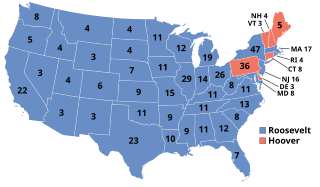
Presidential elections were held in the United States on November 8, 1932. Against the backdrop of the Great Depression, incumbent Republican President Herbert Hoover was defeated in a landslide by Democrat Franklin D. Roosevelt, the governor of New York and the vice presidential nominee of the 1920 presidential election. Roosevelt was the first Democrat in 80 years to simultaneously win an outright majority of the electoral college and popular vote, a feat last accomplished by Franklin Pierce in 1852, as well as the first Democrat in 56 years to win a majority of the popular vote, which was last achieved by Samuel J. Tilden in 1876. Roosevelt was the last sitting governor to be elected president until Bill Clinton in 1992. Hoover became the first incumbent president to lose an election to another term since William Howard Taft in 1912, the last to do so until Gerald Ford lost 44 years later, and the last elected incumbent president to do so until Jimmy Carter lost 48 years later. The election marked the effective end of the Fourth Party System, which had been dominated by Republicans. It was the first time since 1916 that a Democrat was elected president.

John Harper Trumbull was an American politician who served as the 70th Governor of Connecticut.

The 1932 United States Senate election in Connecticut was held on November 8, 1932. Incumbent Senator Hiram Bingham III ran for a second full term in office but was defeated by Democratic U.S. Representative Augustine Lonergan. This was the first time since 1879 that Democrats won this Senate seat, and the first since 1881 that they won either seat.

Two United States Senate elections in Connecticut were held on November 5, 1946, to determine the next United States senator from Connecticut. One election determined who would complete the remainder of deceased Senator Francis T. Maloney's term and the other was for the regularly-scheduled term from 1947 to 1953.

The 1964 United States Senate election in Wisconsin was held on November 3, 1964. Incumbent Democrat William Proxmire was re-elected to a second term in office over Republican Wilbur Renk.

The 1936 United States presidential election in Ohio was held on November 3, 1936, as part of the 1936 United States presidential election. State voters chose 26 electors to the Electoral College, who voted for president and vice president.

The 1938 Connecticut gubernatorial election was held on November 8, 1938. Republican nominee Raymond E. Baldwin defeated Democratic incumbent Wilbur Lucius Cross with 36.43% of the vote.

The 1936 Connecticut gubernatorial election was held on Tuesday November 3, to elect Governor of Connecticut Incumbent Governor Wilbur Lucius Cross defeated Republican nominee Arthur M. Brown with 55.29%, 372,953 votes.

The 1934 Connecticut gubernatorial election was held on November 6, 1934. Incumbent Democrat Wilbur Lucius Cross defeated Republican nominee Hugh Meade Alcorn with 46.71% of the vote.

The 1930 Connecticut gubernatorial election was held on November 4, 1930. Democratic nominee Wilbur Lucius Cross defeated Republican nominee Ernest E. Rogers with 49.91% of the vote.

The 1928 Connecticut gubernatorial election was held on November 6, 1928. It was a rematch of the 1926 Connecticut gubernatorial election. Incumbent Republican John H. Trumbull defeated Democratic nominee Charles G. Morris with 53.57% of the vote.

The 1926 Connecticut gubernatorial election was held on November 2, 1926. Incumbent Republican John H. Trumbull defeated Democratic nominee Charles G. Morris with 63.58% of the vote.

The 1905 Rhode Island gubernatorial election was held on November 7, 1905. Incumbent Republican George H. Utter defeated Democratic nominee Lucius F. C. Garvin with 53.30% of the vote.

The 1904 Rhode Island gubernatorial election was held on November 8, 1904. Republican nominee George H. Utter defeated Democratic incumbent Lucius F. C. Garvin with 48.94% of the vote.

The 1903 Rhode Island gubernatorial election was held on November 3, 1903. Incumbent Democrat Lucius F. C. Garvin defeated Republican nominee Samuel Pomeroy Colt with 49.29% of the vote.

The 1902 Rhode Island gubernatorial election was held on November 4, 1902. Democratic nominee Lucius F. C. Garvin defeated incumbent Republican Charles D. Kimball with 53.99% of the vote.

The 1901 Rhode Island gubernatorial election was held on November 5, 1901. Incumbent Republican William Gregory defeated Democratic nominee Lucius F. C. Garvin with 53.64% of the vote.

The 1932 New York City special mayoral election was held on November 8. It was triggered by the resignation of incumbent Democratic Mayor Jimmy Walker on September 1, after his administration had become embroiled in scandal. Democratic nominee John P. O'Brien easily defeated Republican Lewis H. Pounds and Socialist Morris Hillquit. Acting Mayor Joseph V. McKee also featured as a write-in candidate. Minor candidates included Communist William L. Patterson and Socialist Labor candidate Olive Johnson.

The 1932 Wisconsin gubernatorial election was held on November 8, 1932. Incumbent Republican Governor Philip La Follette was defeated in the Republican primary, and in the midst of the Great Depression and nationwide voter dissatisfaction with the Republican Party, Democratic nominee Albert G. Schmedeman defeated Republican nominee Walter J. Kohler Sr. and Socialist nominee Frank Metcalfe with 52.48% of the vote. Schmedeman became the first Democrat to win a gubernatorial election in Wisconsin since George Wilbur Peck in 1892. Two years later, in 1934, La Follette would run for governor again and defeated Schmedeman, this time running with the Progressive Party.

The 1892 Wisconsin gubernatorial election was held on November 8, 1892. Incumbent Democratic Governor George Wilbur Peck narrowly defeated Republican nominee John Coit Spooner, becoming the first Democratic governor of Wisconsin to be reelected since Nelson Dewey in 1849.
























